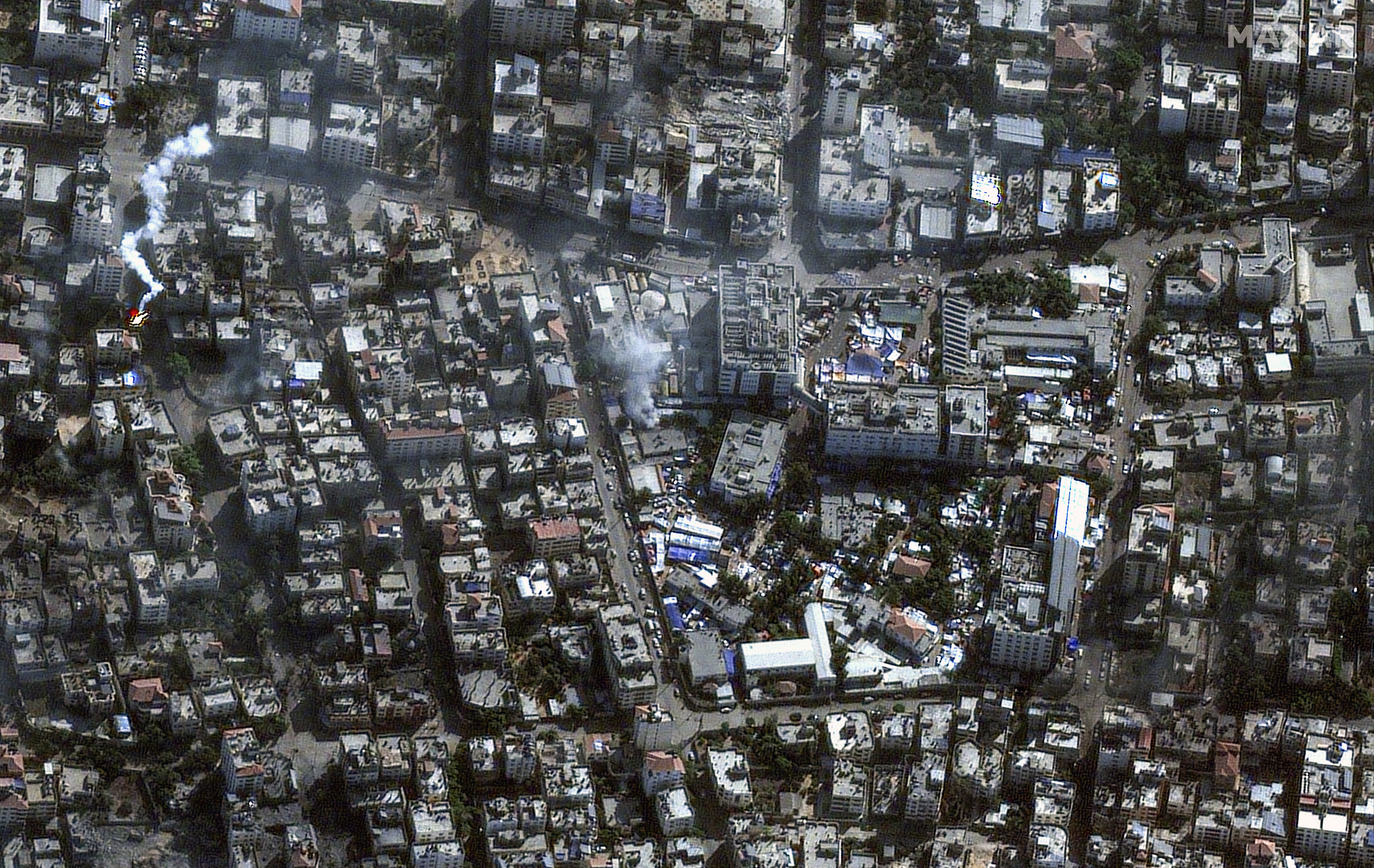US has sent Israel data on aid group locations to try to prevent strikes
Among the sites provided to the Israeli government are medical facilities, including Al-Shifa hospital, which Israeli forces raided last week.


The Biden administration has been providing Israel with the location of humanitarian groups in Gaza for weeks to prevent strikes against their facilities. But Israel has continued to hit such sites.
The information included GPS coordinates of a number of medical facilities and information on movements of aid groups in Gaza to the Israeli government for at least a month, according to three people familiar with the communications. All were granted anonymity because they feared speaking publicly would make it more difficult for aid groups to operate in Gaza.
Still, Israel has launched operations against Hamas in or near aid sites, including hospitals, leading to the destruction of buildings and the blocking of fuel and other critical supplies.
It’s unclear if the U.S. has compiled a formal “no-strike” list or if it is providing one-off guidance. But officials have helped transmit coordinates of groups that provide food and medical care in Gaza and operate out of hospitals, smaller offices and live in guest houses. Among the sites provided to the Israeli government are medical facilities, including Al-Shifa hospital, parts of which Israeli forces took over on Nov. 15.
In public statements, U.S. officials have stressed that aid groups are struggling to operate in the Gaza Strip because of Hamas, noting the militant group uses civilians as human shields and operates tunnels underneath hospitals.
But Israel’s continued bombardment of these humanitarian facilities raises more questions about whether Washington has the political sway many in the administration want with Israel. And the divide is particularly stark given that the goal is protecting aid workers — one of the most fundamental tenets of international humanitarian law.
“It could be that the Biden administration is trying behind the scenes … but they probably aren’t getting anywhere. When the Israelis feel that they're in an existential threat situation, the amount of American leverage drops,” said Robert Ford, a former U.S. diplomat who served extensively in the Middle East, including under President Barack Obama.
The National Security Council pointed to spokesperson John Kirby’s previous comments during Monday’s press conference, in which he told reporters the administration does not “want to see hospitals as battlegrounds.”
On Tuesday, U.S. officials said an announcement of a deal between Israel and Hamas for the release of hostages and a pause in fighting was imminent. But such a pause would likely only take effect for a few days, and Israel has given no indication it would adjust its targeting of sites afterward.
Those who’ve worked for aid groups in the region say Israel is deserting practices it has used previously to protect humanitarian groups.
"There is really no justification for the lack of a functioning deconfliction channel with aid groups,” said a senior aid group official who has worked on previous crises across the region. “The IDF is familiar with deconfliction practices and has put a channel in place in previous conflicts.”
The U.S. is far from the only group providing such data to Israel. The main clearinghouse for so-called humanitarian deconfliction is the United Nations. Humanitarian organizations in Gaza say they primarily rely on the U.N. system and send their coordinates to the U.S. — and directly to the Israeli government — as a stopgap in an effort to prevent further civilian casualties under intensifying bombardment.
Aid groups, particularly those working in hospitals in Gaza, said Israel’s operations have made it almost impossible to continue providing care to patients, including premature babies.
“I have spent my entire adult professional life working on basically medical care in conflict zones, and I have never seen anything like this,” said Dr. Amber Alayyan, a physician with Doctors Without Borders. “It's not only attacks on structures that should be safe, like hospitals and schools, but also holding an entire population without food or water or fuel for over a month.”
The Israel Defense Forces did not respond to requests for comment. Jessica Jennings, a spokesperson with USAID — the agency that supports some aid groups operating in Gaza — said the U.S. is “engaging” the United Nations and the Israeli government “on protecting humanitarian and civilian movements and infrastructure.”
But a U.N. official familiar with refugee operations in Gaza said Israel often defines targets as worthy of strikes despite there being a humanitarian site or activity nearby.
“We don’t see eye-to-eye on what they consider collateral damage or military necessity and what we consider a very high civilian toll, whether it’s in life or in infrastructure, including ours,” said the official, who was granted anonymity to discuss sensitive conversations. “The response we get is, ‘Well, your school is in the middle of what we consider to be a military or an operation area.’”
David Satterfield, the U.S. special envoy for Middle East humanitarian issues, said at a public event with Al-Monitor that the administration asked Israel to create a “single, coordinated, functional deconfliction mechanism.”
“Over the last 48 hours following several tragic incidents in which there were attacks … suffered by humanitarian agencies, we impressed upon Israel that more had to be done,” Satterfield said. “Israel does recognize the need and is acting.”
Deconfliction
Soon after Hamas attacked Israel on Oct. 7, aid groups in Gaza sent their coordinates to the United Nations — using a longstanding arrangement called the Humanitarian Notification System — to prevent incidental attacks on civilians. HNS was used by Israel during the 2014 war with Hamas in Gaza. It is just one of several such systems that exist in conflict zones around the world.
But last month, as aerial bombardments ratcheted up in Gaza, aid groups searched for additional communication channels to share their GPS coordinates and information about their work, including calling senior U.S. officials and members of Congress — hoping that Washington could help protect their workers, two of the people familiar with the matter said.
However, as Washington engaged with the Israeli government about the locations of aid groups’ offices, guest houses and medical facilities, attacks on aid workers continued.
Human Rights Watch said an Israeli airstrike hit an area behind the Indonesian Hospital in Gaza that killed two people, according to the United Nations. The United Nations Relief and Works Agency, one of the U.N. aid agencies operating in Gaza, said that 176 people sheltering in its facilities have been reported killed during “Israeli forces’ bombardment.”
Doctors Without Borders said last week that its staff had sheltered in the organization’s offices and guest houses, and despite outreach to the Israeli government, could not leave.
“We shared our coordinates. We were asked [by the Israelis] to evacuate our guest house. We still, however, have staff sheltering there with their families and they are stuck and they're out of water and they are out of food,” Alayyan said. “We are begging — begging — to be able to let civilians move.”
Improving the system
It’s unclear whether Israel is choosing to ignore the provided information or if the deconfliction systems are simply too patchy. Either possibility is alarming given that the Israel-Hamas war is already in its second month, with no end in sight.
“The situation is without parallel,” said one aid group leader whose organization works in Gaza and who was granted anonymity because they feared for aid workers safety on the ground. “This kind of concentrated bombing in such a small area makes deconfliction all the more important.”
Aid groups are crucial lifelines for Palestinian civilians caught in the crossfire, and their leaders argue that it is critical that the parties at war, including the militants of Hamas, spare them.
Humanitarian organizations and U.S. officials say the U.N. notification system needs to be improved.
Despite the multiple channels for coordinate sharing, more U.N. aid workers have been killed in Gaza this year than in any other conflict in the agency’s history. While details of their deaths have not always been made available, U.N. and other aid groups have said that many of their staff have died in the course of living their everyday lives and outside of their official duties. (Those private activities are not reported to the notification system.)
Asked if the U.N. notification system alerts Hamas to aid groups’ activities and sites, a U.N. official familiar with the issue said the Gaza system tries to notify “all parties to a conflict, including non-state actor groups and other de facto authorities.”
“What we're seeing in terms of the scale of conflict now is very different than it was previously,” the official said. “We are trying to streamline so [the Israelis] can, maybe under this environment, they don’t get overwhelmed.”
Asked if the U.N. effort to help the Israelis better use the notification system was an indication that they were not doing it well, the U.N. official replied: “We’ve had over 50 facilities hit or damaged.”
Still, the U.N. official and others familiar with the topic said the Israeli government appears willing to improve the system. “They are working with us,” the U.N. official said.



